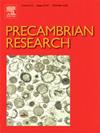Crustal maturation of the Yangtze Block during the Meso-Neoarchean
IF 3.2
2区 地球科学
Q2 GEOSCIENCES, MULTIDISCIPLINARY
引用次数: 0
Abstract
The transition in felsic magmatism from Na-rich TTG suites to K-rich granites during the Mesoarchean to Neoarchean varies from craton to craton, marking the crustal maturation of the ancient continental crust. However, the crustal maturation history of the Yangtze Block is less well constrained due to poor exposure of Archean igneous rocks. In this study, we report a suite of late Mesoarchean mozo-granites from the SW Yangtze Block by providing new whole-rock major and trace element data, along with zircon U-Pb-Hf-O isotopic analyses, to constrain their petrogenesis. Zircon U-Pb dating shows that the studied mozo-granites have a crystallization age of ∼2.8 Ga. Geochemically, they exhibit high heavy rare earth element (HREE) contents and elevated K/Na ratios, typical of potassic granites derived from a shallow crust source. By integrating zircon Hf-O isotopes with thermodynamic modelling, we propose that these potassic granites were products of partial melting of an isotopically juvenile tonalitic crust. Furthermore, Bayesian change-point analysis detected a step increase in K/Na ratios at ∼2.7 Ga, which we interpret as the final stage of crustal maturation for the Yangtze Block. The intracrustal melting of TTG crust during the late Mesoarchean to Neoarchean contributed significantly to stabilization of the Archean continental crust during that period.
中-新太古代扬子地块的地壳成熟
中太古宙至新太古宙长英质岩浆活动从富钠TTG套向富钾花岗岩的转变在克拉通和克拉通之间有所不同,标志着古大陆地壳的成熟。然而,由于太古宙火成岩的暴露程度较低,对扬子地块的地壳成熟历史约束较少。本文报道了一套来自西南扬子地块的中太古代晚期莫佐花岗岩,通过提供新的全岩主微量元素数据,以及锆石U-Pb-Hf-O同位素分析,对其岩石成因进行了限定。锆石U-Pb测年表明,所研究的莫索花岗岩的结晶年龄为~ 2.8 Ga。地球化学上,它们表现出高重稀土元素(HREE)含量和高K/Na比值,具有典型的浅壳源钾质花岗岩特征。通过将锆石Hf-O同位素与热力学模型相结合,我们提出这些钾质花岗岩是同位素幼年型调质地壳部分熔融的产物。此外,贝叶斯变点分析发现,在~ 2.7 Ga时,K/Na比值逐步增加,我们将其解释为扬子地块地壳成熟的最后阶段。中太古宙晚期至新太古宙TTG地壳的壳内熔融对该时期太古宙大陆地壳的稳定起着重要作用。
本文章由计算机程序翻译,如有差异,请以英文原文为准。
求助全文
约1分钟内获得全文
求助全文
来源期刊

Precambrian Research
地学-地球科学综合
CiteScore
7.20
自引率
28.90%
发文量
325
审稿时长
12 months
期刊介绍:
Precambrian Research publishes studies on all aspects of the early stages of the composition, structure and evolution of the Earth and its planetary neighbours. With a focus on process-oriented and comparative studies, it covers, but is not restricted to, subjects such as:
(1) Chemical, biological, biochemical and cosmochemical evolution; the origin of life; the evolution of the oceans and atmosphere; the early fossil record; palaeobiology;
(2) Geochronology and isotope and elemental geochemistry;
(3) Precambrian mineral deposits;
(4) Geophysical aspects of the early Earth and Precambrian terrains;
(5) Nature, formation and evolution of the Precambrian lithosphere and mantle including magmatic, depositional, metamorphic and tectonic processes.
In addition, the editors particularly welcome integrated process-oriented studies that involve a combination of the above fields and comparative studies that demonstrate the effect of Precambrian evolution on Phanerozoic earth system processes.
Regional and localised studies of Precambrian phenomena are considered appropriate only when the detail and quality allow illustration of a wider process, or when significant gaps in basic knowledge of a particular area can be filled.
 求助内容:
求助内容: 应助结果提醒方式:
应助结果提醒方式:


